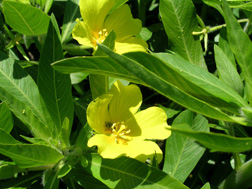This page has been archived and is being provided for reference purposes only. The page is no longer being updated, and therefore, links on the page may be invalid.
|
Read the magazine story to find out more. |
|
|
Water Primrose: Aquatic Invader Targeted
By Marcia WoodMay 15, 2006
Lovely but troublesome, a yellow-flowered plant called water primrose ranks as a prime target of Agricultural Research Service (ARS) scientists who want to squelch the spread of this water invader. Cristina Hernández at the agency’s South American Biological Control Laboratory in Hurlingham, Argentina, leads the search for weevils and other natural enemies of the invasive plant.
Candidate critters that pass rigorous tests to ensure they attack only water primrose—and not someone’s prized roses, for instance—may someday be approved for use in the United States to attack the aquatic weed.
Today, water primrose (Ludwigia species) that are native to South America infest ponds, lakes, streams, rivers, canals and reservoirs on both East and West coasts of the United States—as well as some inland sites.
The plant crowds out native vegetation and clogs waterways, which can lead to flooding not only of growers’ fields, orchards or vineyards, but also riparian parks, nature preserves and more.
The research, a resumption of studies begun in the 1970s, should help the health not only of waterways but of people and animals, too. That’s because water primrose presents a haven for mosquitoes that could carry West Nile virus. The virus, a relative newcomer to the United States, can infect humans, horses, birds and other forms of life.
Hernández and coinvestigators—including Willie Cabrera Walsh at Hurlingham and ARS scientists based in California—have found that some weevils noted in the earlier ARS studies still show promise as potential candidates for attacking water primrose invasions in the United States.
Read more about the research in the May 2006 issue of Agricultural Research magazine.
ARS is the U.S. Department of Agriculture’s chief scientific research agency.

